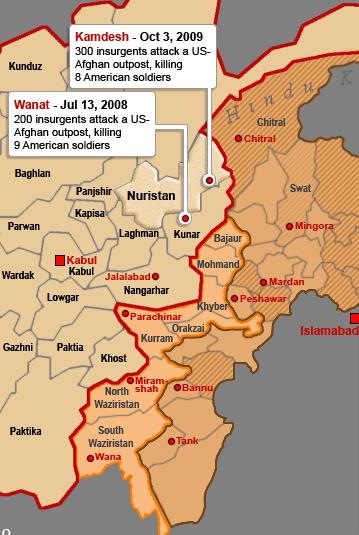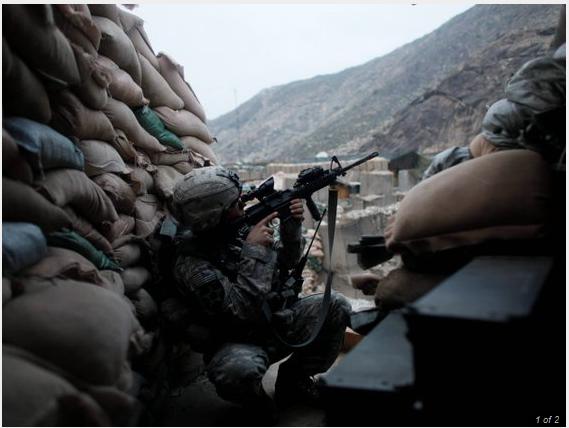Atmospherics, Intelligence and Local Spotters
BY Herschel SmithOne of our favorite war correspondents, C.J. Chivers, gives us a view of the U.S. Marines’ fight in the Helmand Province against a shadowy insurgency which uses centuries-old communications techniques.
KARARDAR, Afghanistan — The Marine infantry company, accompanied by a squad of Afghan soldiers, set out long before dawn. It walked silently through the dark fields with plans of arriving at a group of mud-walled compounds in Helmand Province at sunrise.
The company had received intelligence reports that 40 to 50 Taliban fighters had moved into this village a few days before, and the battalion had set a cordon around it. The Marines hoped to surprise any insurgents within.
But as the company moved, shepherds whistled in the darkness, passing warning of the Americans’ approach. Dogs barked themselves hoarse. The din rose in every direction, enveloping the column in noise. And then, as the Marines became visible in the bluish twilight, a minivan rumbled out of one compound. Its driver steered ahead of the company, honking the van’s horn, spreading the alarm. Spotters appeared on roofs.
Marine operations like this one in mid-January, along with interviews with dozens of Marines, reveal the insurgents’ evolving means of waging an Afghan brand of war, even as more American troops arrive.
Mixing modern weapons with ancient signaling techniques, the Taliban have developed the habits and tactics to evade capture and to disrupt American and Afghan operations, all while containing risks to their ranks.
Bruce Rolston reacts with some head-shaking at one of the supposed signaling techniques – kite flying.
The only quibble I have is with some of of the low-tech “signals” Chivers offers. One of the photo captions refers to shepherd’s whistles, and the article refers to kites. This is probably an indication either Chivers or someone he interviewed has been paying too much attention to the fever-dreams of fobbits.*
Kite flying is ubiquitous in Afghanistan, but it would be a lousy choice of signal of an enemy presence, relying for success in a pinch on two fairly unreliable things: wind, and boys (not to mention daylight). Even if it worked, presumably you’d have to do something special, like fly a different kite, to distinguish it from all the other kites. Its use as a signal of the presence of troops seems to be another one of those Afghan “urban legends,” a classic example of false correlation in intelligence reporting. Kite flying is fairly unusual to Westerners, so patrol reports can often mention it just as an observation …
I once made the rare mistake of passing on an RFI on local kite-flying patterns along these lines from a higher headquarters to our guys uncritically. I was rapidly slapped down by one of the guys in Tacnet email for passing on a junk request, something along the lines of “the kids are flying kites around me now. They were flying them yesterday. If I walk to the next village they’ll be flying there. They’ll be flying them tomorrow if there’s any wind… tell them to factor that into their analysis and get back to me when they have something useful to ask me.”
Bruce goes on to point out that infrequent patrols can lead to misunderstanding of the atmospherics. Valid point. But the Marines – the ultimate foot warrior – are not usually bound to vehicles, and are more diligent still to ensure contact with the population (even if they ensure force protection for sleep or down time). More likely, they will soon learn that kite flying is more common in Afghanistan than the U.S.
That doesn’t detract from the salient point of the article and it shouldn’t cause us to lose attention to a critical aspect of these engagements, namely that these networks must be dismantled. A well placed sniper’s bullet to a spotter on the roof or the arrest of one of the farmers or shepherds (and long term detention) should convince them that there isn’t any mileage in siding with the insurgents.
What evidence do I have that such an approach would work? It should be remembered that the usual objection to robust tactics is that they don’t comport with population-centric counterinsurgency doctrine. It should also be remembered that the doctrine is, after all, just doctrine. It’s usually left to the Lance Corporals and Sergeants in the field to find what works. In Ramadi as I have pointed out before, it was robust tactics.
Costa … dedicated a portion of his time to cracking the insurgents’ methods of communication.
“Generally there was a guy putting up gang signs, which could either send a rocket-propelled grenade through your window or some other attack your way,” said Costa, who began to realize the significance of unarmed people on Ramadi’s streets providing information via visual cues.
“You’re watching something on the street like that happening, and you’re like, ‘What the hell is that guy doing?’” he recalled. “And then the next thing you know, insurgents start coming out of the woodwork.”
“Signalers” — the eyes and ears of insurgent leaders — informed the insurgent strategists who commanded armed fighters by using hand and arm gestures. “You could see the signaler commanding troops,” Costa recalled. “He just doesn’t have a weapon.”
To curb insurgents’ ability to communicate, Costa decided on a revolutionary move: He and his unit would dismantle the enemy’s communication lines by neutralizing the threat from signalers. Sparing no time, he set a tone in Ramadi that signalers would be dealt with no differently from their weapon-wielding insurgent comrades.
“We called it in that we heard guys were signaling, and the battalion would advise from there,” he said, recalling the first day of the new strategy. “We locked that road down pretty well that day.”
In ensuing weeks, coalition forces coordinated efforts to dismember the insurgent signal patterns entrenched in Ramadi. This helped tamp down violence and create political breathing room, which in turn allowed the forging of key alliances between local tribal sheiks and coalition operators. The subsequent progress was later dubbed the “Anbar Awakening,” a societal purging of extremism by Anbaris that ushered in a level of stability unprecedented since U.S. operations in Iraq began.
With insurgents, there is nothing new under the sun (Eccl 1:9). With counterinsurgents, we seem to want to reinvent our doctrine when it isn’t necessary. Just ask the enlisted men what they did “back in the olden days.”





